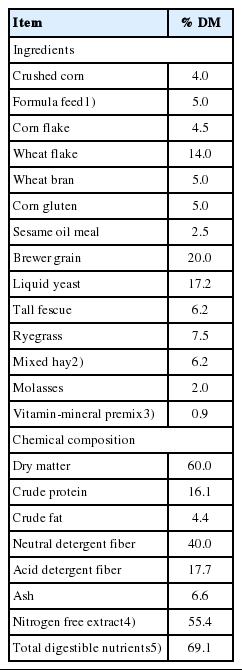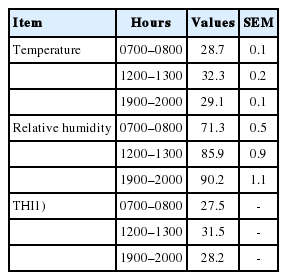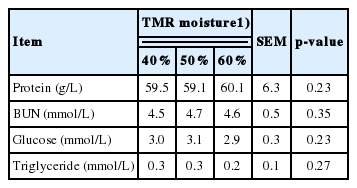Effects of water addition to total mixed ration on water intake, nutrient digestibility, wool cortisol and blood indices in Corriedale ewes
Article information
Abstract
Objective
The objective of this study was to determine the effect of adding water to total mixed ration (TMR) on fresh water intake, nutrient digestibility, wool cortisol, and blood indices in Corriedale ewes under hot and humid conditions.
Methods
Nine non-pregnant Corriedale ewes (ave. body weight = 41±3.5 kg) were individually fed diets based on maintenance requirements in metabolic crates. Ewes were assigned to three treatment groups according to a triplicate 3×3 Latin Square design for 3 periods of 21 days duration each (9 ewes per treatment, 27 replications). Treatments were TMR (crude protein [CP] = 16.1, total digestible nutrients = 69.1%) moisture levels for 40%, 50%, and 60%.
Results
No differences were found in body weight gain among all treatment groups (p>0.05). Nitrogen balance including digestible N, retained N, and urinary and fecal N showed no change among the treatment groups (p>0.05). Fresh water intake was the lower in 50% TMR moisture group than in the other groups (p<0.05). Other than ether extract which was higher in 60% TMR moisture group (p<0.05) the differences among nutrient digestibilities including CP, organic matter, dry matter, neutral detergent fiber, acid detergent fiber, and non-fiber carbohydrate were not significant (p>0.05). No significant difference was observed for serum protein, blood urea nitrogen, glucose, and triglyceride among the treatment groups (p>0.05). Wool and blood cortisol were not different among the treatment groups (p>0.05). Blood hematology including red blood cell, white blood cells, hemoglobin, hematocrit, basophils, and eosinophils were not different among the treatment groups (p>0.05).
Conclusion
It is concluded that TMR moisture at 40%, 50%, and 60% had no effects on N balance parameters, and nutrient digestibilities except for the ether extract under hot and humid conditions. Additionally there were no effects on stress conditions include wool cortisol, as well as blood cortisol levels of ewes.
INTRODUCTION
Feed moisture may change the palatability and dry matter intake (DMI) of feed by the animals. Moreover, earlier studies [1,2] have reported no changes in starch digestibility due to increasing levels of moisture in total mixed ration (TMR).
It was hypothesized that the palatability of the feed particles may decline due to adding water to TMR. While Fish and DeVries [3] observed that total neutral detergent fiber (NDF) and starch intake were not affected by water addition to the diets, in contrast, Miller-Cushon and DeVries [1] and Felton and DeVries [2] reported a reduction in total NDF and starch intakes corresponding to the decrease in DMI. Given that one of the three sources of water supply for the body is feed moisture [4], effects of different moisture content of TMR on nutrient intake, sorting behavior, and production of dairy cows has been investigated [1–3,5]. They concluded that increasing TMR moisture by adding water decreases DMI and consequently other nutrient intake, increases the tendency of sorting against long particles in dairy heifers [6], and declines the production of dairy cows [2]. However, most often adding water to TMR results in a significant change in production due to a decline in DMI as the dry matter (DM) proportion of the TMR falls below 45%.
It should be noted that feed moisture and drinking water is necessary for proper rumination and digestion [7–9], and nutrient digestibility can be improved in animals by decreasing feed intake under heat stress conditions [10,11]. Sheep require less water per unit of feed DM and have drier feces than cows do [8,11]. Adding water to feed is hypothesized to have compensation effects on fresh water intake that may influence the need for water supply to sheep.
The variation in climatic variables like temperature and hu midity are recognized as potential hazards in the growth and production of all domestic livestock species. High ambient temperature accompanied by high air humidity caused an additional discomfort and enhanced the stress levels which in turn resulted in depression of the physiological and metabolic activities of the animal. Measuring the wool cortisol level with a new and accurate approach is a documented measurement to evaluate levels of chronic stress includes heat stress in sheep [7] and cows [12]. Furthermore, researchers [13–15] have reported that in a hot and humid climate, especially with heat stress, may alter serum bio-chemical parameters and hematology [15–17] in livestock due to capacity of the animals to adapt to the new environmental conditions. This and the possible effects of TMR moisture at different levels need to be investigated. Therefore, the effects of adding water to TMR on fresh water intake, nutrient digestibility, stress status in Corriedale ewes, especially during hot and humid conditions were evaluated.
MATERIALS AND METHODS
Animals, treatments and experimental design
The experimental procedure and methods were approved by The Animal Welfare and Ethics Authority of Kangwon National University, Chuncheon, Republic of Korea. Nine non-pregnant 3-yr old Corriedale ewes (ave. body weights [BW] = 41±3.5 kg) were individually fed diets (TMR; crude protein [CP] = 16.1, total digestible nutrients [TDN] = 69.1%) based on maintenance requirements [18] with an additional 10% to ensure that they fed at their maintenance levels. Ewes were kept in metabolic crates (0.75 m ×1.45 m) and were assigned to three different treatment groups according to a triplicate 3×3 Latin Square design for 3 periods of 21-d each (9 sheep per treatment). Treatments involved adding water to TMR in order to increase the moisture to 40%, 50%, and 60%. All ewes had ad-libitum access to water. Water was added to the TMR each time prior to feeding. The control group of TMR provided with 40% moisture. In order to increase the moisture to the TMR up to 50% and 60%, the certain amount of water (calculated based on DM of the TMR) were added each time to each group. Then, after proper mix of added water to the TMR, feed was offered to each ewe.
Ewes were placed in individual metabolic crates with metal grated floors designed for urine and feces collection. Ewes were acclimated to the environment and experimental conditions for 10 d prior the experiment. At the beginning of each experimental period an adaptation period of 14-d was allotted in which ewes were allowed to adapt to the new treatment group to which they were assigned. The remaining 7-d comprised a measurement period, the last of which blood was drawn. Lighting in the experimental house was maintained between 0800 and 2130 h.
Feed, water, wool sample, and urine and fecal collection
Feed was uniformed as a commercial TMR (Table 1) that was weighed and offered twice daily at 0900 h and 1800 h. Ewes were fed at their maintenance levels [18] with an additional 10% of their maintenance requirements throughout the experiment, so that no residual feed remained to weigh each day. The BW were measured on days 1, 14, and 21 of each period. Fresh water intake was recorded two times daily for the 5 final days of each period. Collections of urine and feces were performed daily for the final 7 days of each period, and were stored for analyses. Approximately 200 g of daily fecal excretion from each ewes were sub-sampled to a plastic bag, dried (65°C for 3 days), finely ground (1 mm) and analysed for nutrients including ether extract (method 920.39; [19]), and ash (method 927.02; [19]). The N (except for urine N) was determined by Kjeldahl procedure using Cu2+ as a catalyst, and CP was calculated as N×6.25 (method 984.13; [19]). Urinary N content was analysed as described by El Shazly [20]. Fibre content of feed and feces was determined using the method of Van Soest et al [21]. NDF and acid detergent fiber (ADF) were expressed with residual ash. Nitrogen free extracts (NFE) (Table 1) and non-fiber carbohydrate (NFC) (Table 3) were calculated using the formulas.
Preparing wool for cortisol analysis included shaving from the posterior vertex region of the neck between the cisterna magna and scapular bones, wrapping and unwrapping in aluminum foil, washing with isopropanol and methanol, drying, grinding, and then applying hair cortisol assay using the kit according to the manufacturers recommendation (Salimetrics, high sensitivity salivary cortisol, enzyme immuneassay kit, no. 1–3002, State College, PA, USA). Further details are described by Ghassemi Nejad et al [7]. The intra-assay and inter-assay coefficients of variations were 4.5 and 10.1, respectively.
Blood was collected by jugular venipuncture in two evacuated tubes at 1300 h on day 21 of each period. One sample (anticoagulant: ethylenediaminetetraacetic acid [EDTA], Greiner bio-one, New Orleans, LA, USA, reference no. 456073) was used to determine blood hematology characteristics, and the other (no additive: BD, Franklin Lakes, NJ, USA) was used to determine concentrations of serum protein, urea, glucose, and triglycerides (Modular analytic E170, Roche, Germany). After collection, serum was obtained by centrifugation (1,200×g for 20 min) and then stored at −20°C until analysis. Blood in vacutainers containing EDTA was used for blood hematology including red blood cells (RBC), white blood cells (WBC), hemoglobin, hematocrit, basophils, and eosinophils.
The diurnal temperature and humidity pattern as temperature- humidity index (THI) in the experimental house are presented in Table 2 calculated as suggested by Marai et al [22].
Statistical analysis
The univariate procedure of SAS (version 9.1; SAS institute Inc., Cary, NC, USA) was used to check the normality of data. The result of this analysis showed that the data for all the measured characteristics were normally distributed. Statistical analysis was carried out using the general linear model procedure of SAS for a triplicate 3×3 Latin Square design. The model included effects of ewe, treatment, and period as follows:
Where, Y ijkl = each observation, μ = total mean, αi = effect of treatment, Sj = effects of ewe, Pk = effects of period, and ɛijkl = error. Experimental house environment was controlled throughout the experiment and the effects of ewe and period was not significant. Duncan multiple range test was used for ranking treatment means within a significant F test and statistical differences were considered significant at p<0.05 and differences among means with 0.05<p<0.10 was accepted as representing tendencies to differences.
The THI data were averaged for weekly means (on hourly intervals) and analyzed by analysis of variance as repeated measures using the mixed procedure of SAS (version 9.1; SAS institute Inc., Cary, NC, USA). The covariance structures (autoregressive order 1, unstructured and compound symmetry) for the repeated measures model were tested and the structure which fitted the model best was chosen based on the smallest Schwarts’s Bayesian criterion.
RESULTS
Nitrogen balance, feed intake, fresh water intake, and nutrient digestibility
TMR moisture levels did not affect (p>0.05) N balance including N intake (g/d), fecal N (g/d), digestible N (g/d), urinary N (g/d), retained N (g/d), fecal N/N intake (%), urinary N/N intake (%), and retained N/N intake (%) of the groups (Table 3). Feed intake remained unchanged (p>0.05) during the experiment since animals were fed with an additional 10% of their maintenance level. The breakdown of which is as follows; 2.1 kg, 1.9 kg and 2.0 kg in 40%, 50%, and 60% TMR moisture groups (as-fed prior to water addition to TMR), respectively. Body weight gains (kg) in 40%, 50%, and 60% TMR moisture groups were 1.0±0.1, 1.1±0.5, and 0.9±0.1 kg, respectively. No differences were observed in BW of ewes among treatments (p>0.05). Fresh water intake (L/d) was lower (p = 0.03) in the 50% TMR moisture group among the treatment groups, while no difference (p>0.05) was observed in daily fresh water intake between the 40% and 60% TMR moisture groups (Table 4).
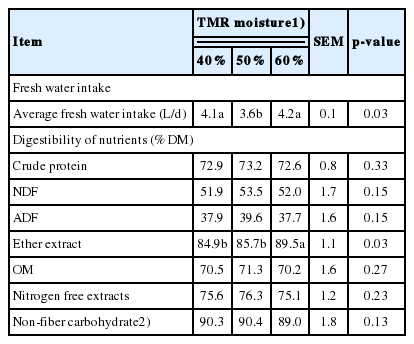
Effects of adding water to TMR on fresh water intake and nutrient digestibility in ewes during hot and humid conditions
Ether extract digestibility showed a higher (p <0.05) value in the 60% TMR moisture group than other groups. However, digestibility of CP, ADF, NDF, organic matter, NFE, and NFC were not different (p>0.05) among any of the treatment groups (Table 4).
Wool cortisol and blood parameters
Wool cortisol concentrations (pg/mg of wool) were not different (p>0.05) among the treatment groups (Table 6). Serum biochemicals including protein (g/L), blood urea nitrogen (BUN) (mmol/L), glucose (mmol/L), and triglyceride (mmol/L) (Table 5), and plasma hematology including RBC (×1012/L), WBC (×109/L), hemoglobin (g/L), hematocrit, basophils (×109/L), and eosinophils (×109/L) were not different (p>0.05) among the treatment groups (Table 6). Overall, wool cortisol and blood parameters remained unaffected by moisture levels of TMR.
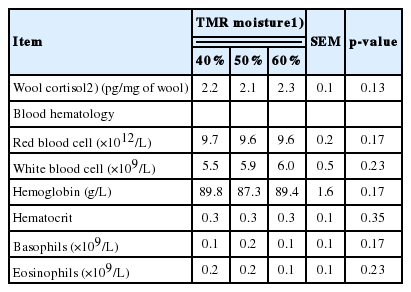
Effects of adding water to TMR on wool cortisol and hematologic characteristics in ewes during hot and humid conditions
DISCUSSION
Positive N retention with different TMR moisture in sheep may reflect recycling of N through the ruminal wall and saliva for microbial synthesis [8,23]. TMR in this study was controlled and had the same uniformed ingredients and chemical compositions. The only variable in the TMR was the DM, due to addition of water to TMR. It may change the palatability and DMI of feed by the animals. Several studies reported no changes in starch digestibility due to the addition of water to TMR [1,2]. They explained that the palatability of the feed particles may decline due to adding water to TMR. While Fish and DeVries [3] observed that total NDF and starch intake were not affected by water addition to the diets, in contrast, Miller-Cushon and DeVries [1] and Felton and DeVries [2] reported a reduction in total NDF and starch intakes corresponding to the decrease in DMI. These can all affect fiber digestibility which we have not found in the present study. This may be explained as due to feeding at the maintenance requirements which resulted in similar DMI and body weight gain. As ewes in the present study were fed diets based on their maintenance requirements it should have not led to a change in body weight and with different TMR moisture levels.
Higher moisture TMR is hypothesized to be associated with being more prone to spoilage due to increased temperature of the TMR during periods of increased environmental temperature [24,25]. Moreover, it could be hypothesized that higher moisture in the ration and higher THI would promote such spoilage. However, in the present study, ewes were fed based on maintenance requirements. Higher TMR moisture was not applicable to higher TMR temperature as the ewes finish eating within a few minutes of being offering the feed and thus there were no observed changes in DMI. Furthermore, moisture levels drive the extent of the fermentation and are associated with the starch digestion rate [2]. Over 50% of TMR moisture is reported to be related to more extensive degradation of protein, poor fermentation quality, and more extensive fermentation that results in high content of free acid and low pH.
Digestibility of CP, ADF, and NDF were not different among the groups; however, higher ether extract digestibility of feed in 60% TMR moisture was observed. In the present experiment the higher moisture may increase the rate of fat bypass to the small intestine which could result in higher ether extract digestibility. As such Miller-Cushon and DeVries [1] demonstrated that the addition of water to a high-moisture TMR will decrease feed sorting, and thus decrease the refusal of NDF, and will ultimately increase milk fat percentage and yield in lactating dairy cows that may be explained due to higher ether extract digestibility.
Buffers can aid in controlling rumen pH. Sodium bicarbonate is the most widely used dietary buffer. Rations which benefit the most from buffers are rations which contain a high moisture level, and low fiber forages. Abnormally fermented material may alter the volatile fatty acid (VFA’s) and lactic acid in the rumen [9]. Feed moisture is associated with saliva secretion. High moisture feeds can reduce saliva produced per kilogram of DMI by 50%. It also may have compensation effects on fresh water intake of sheep. We hypothesized that an increase in TMR moisture may be associated with fresh water intake. In such a case, the reason(s) for lower fresh water intake in 50% TMR moisture group than other groups and also similar fresh water intake in 40% and 60% TMR moisture group remains unknown. Ruminants have developed high water efficiency with improved utilization of body water resulting in the maintenance of DMI and performance [26]. It is commonly believed that addition of water to TMR will bind particles together and make it harder for the animals to sort out fine particles [1]. However, Leonardi et al [27] showed a reduction in the extent of feed sorting against long particles only when water was added to TMR up to 80% of DM. This and the fact that ewes in this study were fed based on maintenance requirements may explain why addition of water to TMR (maximum 60%) had no extensive influence on fresh water intake and the related parameters. In addition, future investigations by feeding higher moisture TMR for over 60% may improve our understanding of how possibly can affect fresh water intake.
More et al [13] reported a significant increase in the serum protein of sheep exposed to heat stress. The increase in serum protein could be a physiological attempt to maintain extended plasma volume. Glucose, BUN, and triglyceride may change due to high ambient temperature in camel [14,15]; however, the results of this investigation showed that adding water to TMR for 40% to 60% moisture has no significant influence on serum protein, BUN, glucose, triglyceride in ewes. These phenomena could be explained by the high potential of adaptability of the ewes in this study under the environmental conditions which is not influenced by the level of TMR moisture.
No differences in wool cortisol levels show that TMR mois ture at 40% to 60% did not affect chronic stress in ewes under the experimental conditions. Ghassemi Nejad et al [12] found no difference in hair cortisol levels under heat stress conditions in lactating cows with different hair color (black vs white). In contrast Ghassemi Nejad et al [7] reported in elevated wool cortisol in ewes under similar environmental conditions but with water restrictions for 2 h and 3 h following feeding as treatment groups. In this study, concentrations of WBC remained constant among the treatment groups. Blood indices may change with stressors such as environment or temperature [28]. Decreases in hematocrit values during the hot season are partially due to a decrease in circulating erythrocytes. Other researchers [16,29] have verified a depression in hematocrit and erythrocytes in cattle subjected to elevated ambient temperatures and suggest that an increased rate of erythrocyte destruction may be responsible. In this study, RBC and hematocrit values remained unchanged among the treatment groups. No change in blood hematology parameters and biochemical with changes in TMR moisture from 40% to 60% revealed that TMR moisture potentially does not affect these parameters in particular.
CONCLUSION
This study aimed to investigate the effects of feeding different levels of TMR moisture for 40% to 60% during hot and humid conditions, regarding the fresh water intake, wool cortisol, blood indices, and nutrient digestibility of ewes. We found that TMR moisture is not linearly associated with fresh water intake. It was also observed that different levels of TMR moisture did not affect chronic stress conditions – wool cortisol, nutrient digestibility except ether extract of ewes under hot and humid conditions. We concluded that the moisture of the feed can apply from the range of 40% to 60% with no adverse effects on the welfare and nutrition of the ewes.
ACKNOWLEDGMENTS
This study was supported by a grant from the Bio-industry Technology Development Program (313020-04), Ministry of Agriculture, Food, and Rural Affairs, Republic of Korea. The authors thank to Jennette B.A. Cabibi (Elmira College, SUNY University, USA) for her professional help in editing the manuscript.
Notes
CONFLICT OF INTEREST
We certify that there is no conflict of interest with any financial organization regarding the material discussed in the manuscript.
